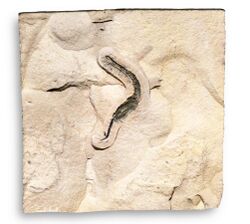Biology:Soluta (echinoderm)
| Soluta | |
|---|---|

| |
| Fossil specimen of Coleicarpus sprinklei | |

| |
| Silhouette of Castericystis | |
| Scientific classification | |
| Domain: | Eukaryota |
| Kingdom: | Animalia |
| Superphylum: | Deuterostomia |
| Clade: | Ambulacraria |
| Phylum: | Echinodermata |
| Class: | †Soluta Jaekel, 1901 |
| Orders | |
| |
Soluta is an extinct class of echinoderms that lived from the Middle Cambrian to the Early Devonian.[1] The class is also known by its junior synonym Homoiostelea. Soluta is one of the four "carpoid" classes, alongside Ctenocystoidea, Cincta, and Stylophora, which made up the obsolete subphylum Homalozoa. Solutes (or solutans) were asymmetric animals with a stereom skeleton and two appendages, an arm extending anteriorly and a posterior appendage called a homoiostele.
Biology
Most solutes were free-living, but the basal solutan Coleicarpus used its homoiostele as a holdfast, as did juvenile Castericystis.[2][3]
Classification
| |||||||||||||||||||||||||||||||||||||||||||||||||||||||||||||||||||||||||||
| Phylogenetic relationships within Soluta[4] |
The phylogenetic position of Soluta is contentious. Solutans are widely agreed to be echinoderms, though the outmoded[5] calcichordate hypothesis held that they were ancestral to both echinoderms and chordates.[6] Within echinoderms, one hypothesis holds that stylophorans are stem-group echinoderms which branched off before echinoderms evolved radial symmetry.[7] Another hypothesis holds that they are specialized descendants of radiate echinoderms which lost radial symmetry, likely belonging to Blastozoa.[8]
Solutes are divided into two orders, Syringocrinida and Dendrocystitida.[9]
Distribution
The earliest solutes, Coleicarpus and Castericystis, lived during the Drumian age of the Cambrian.[3] Solutes were the last of the four carpoid classes to appear in the fossil record. Solutes appear to have evolved in Laurentia,[3] but became more widespread during the Ordovician.[10]
References
- ↑ Lefebvre, Bertrand; Derstler, Kraig; Sumrall, Colin D. (2012). "A reinterpretation of the solutan Plasiacystis mobilis (Echinodermata) from the Middle Ordovician of Bohemia". Zoosymposia 7: 287–306. doi:10.11646/zoosymposia.7.1.27.
- ↑ Daley, Paul E. J. (1996). "The first solute which is attached as an adult: a Mid-Cambrian fossil from Utah with echinoderm and chordate affinities". Zoological Journal of the Linnean Society 117 (4): 405–440. doi:10.1111/j.1096-3642.1996.tb01659.x. ISSN 0024-4082.
- ↑ 3.0 3.1 3.2 Lefebvre, Bertrand; Lerosey-Aubril, Rudy (2017). "Laurentian origin of solutan echinoderms: new evidence from the Guzhangian (Cambrian Series 3) Weeks Formation of Utah, USA". Geological Magazine 155 (5): 1190–1204. doi:10.1017/S0016756817000152. https://www.cambridge.org/core/product/identifier/S0016756817000152/type/journal_article.
- ↑ Parsley, Ronald L.; Rozhnov, Sergei V.; Sumrall, Colin D. (2012). "Morphologic and systematic revision of the solute Maennilia estonica (Homoiostelea, Echinodermata) from the Upper Ordovician of Estonia". Journal of Paleontology 86 (3): 462–469. doi:10.1666/11-083.1. https://www.cambridge.org/core/product/identifier/S0022336000000524/type/journal_article.
- ↑ Rahman, Imran A. (2009). "Making sense of carpoids". Geology Today 25 (1): 34–38. doi:10.1111/j.1365-2451.2009.00703.x. http://doi.wiley.com/10.1111/j.1365-2451.2009.00703.x.
- ↑ Jefferies, R. P. S. (1990). "The solute Dendrocystites scoticus from the Upper Ordovician of Scotland and the ancestry of chordates and echinoderms". Palaeontology 33 (3): 631–679.
- ↑ Smith, Andrew B. (2005). "The pre-radial history of echinoderms". Geological Journal 40 (3): 255–280. doi:10.1002/gj.1018. http://doi.wiley.com/10.1002/gj.1018.
- ↑ David, Bruno; Lefebvre, Bertrand; Mooi, Rich; Parsley, Ronald (2000). "Are homalozoans echinoderms? An answer from the extraxial-axial theory". Paleobiology 26 (4): 529–555. doi:10.1666/0094-8373(2000)026<0529:AHEAAF>2.0.CO;2. http://www.bioone.org/doi/abs/10.1666/0094-8373%282000%29026%3C0529%3AAHEAAF%3E2.0.CO%3B2.
- ↑ Noailles, Fleur; Lefebvre, Bertrand; Kašička, Libor (2014). "A probable case of heterochrony in the solutan Dendrocystites Barrande, 1887 (Echinodermata: Blastozoa) from the Upper Ordovician of the Prague Basin (Czech Republic) and a revision of the family Dendrocystitidae Bassler, 1938". Bulletin of Geosciences 89 (3): 451–476. doi:10.3140/bull.geosci.1475. ISSN 1214-1119.
- ↑ Zamora, Samuel; Lefebvre, Bertrand; Javier Álvaro, J.; Clausen, Sébastien; Elicki, Olaf; Fatka, Oldrich; Jell, Peter; Kouchinsky, Artem et al. (2013). "Cambrian echinoderm diversity and palaeobiogeography". Geological Society, London, Memoirs 38 (1): 157–171. doi:10.1144/M38.13.
Wikidata ☰ Q56317646 entry
 |

